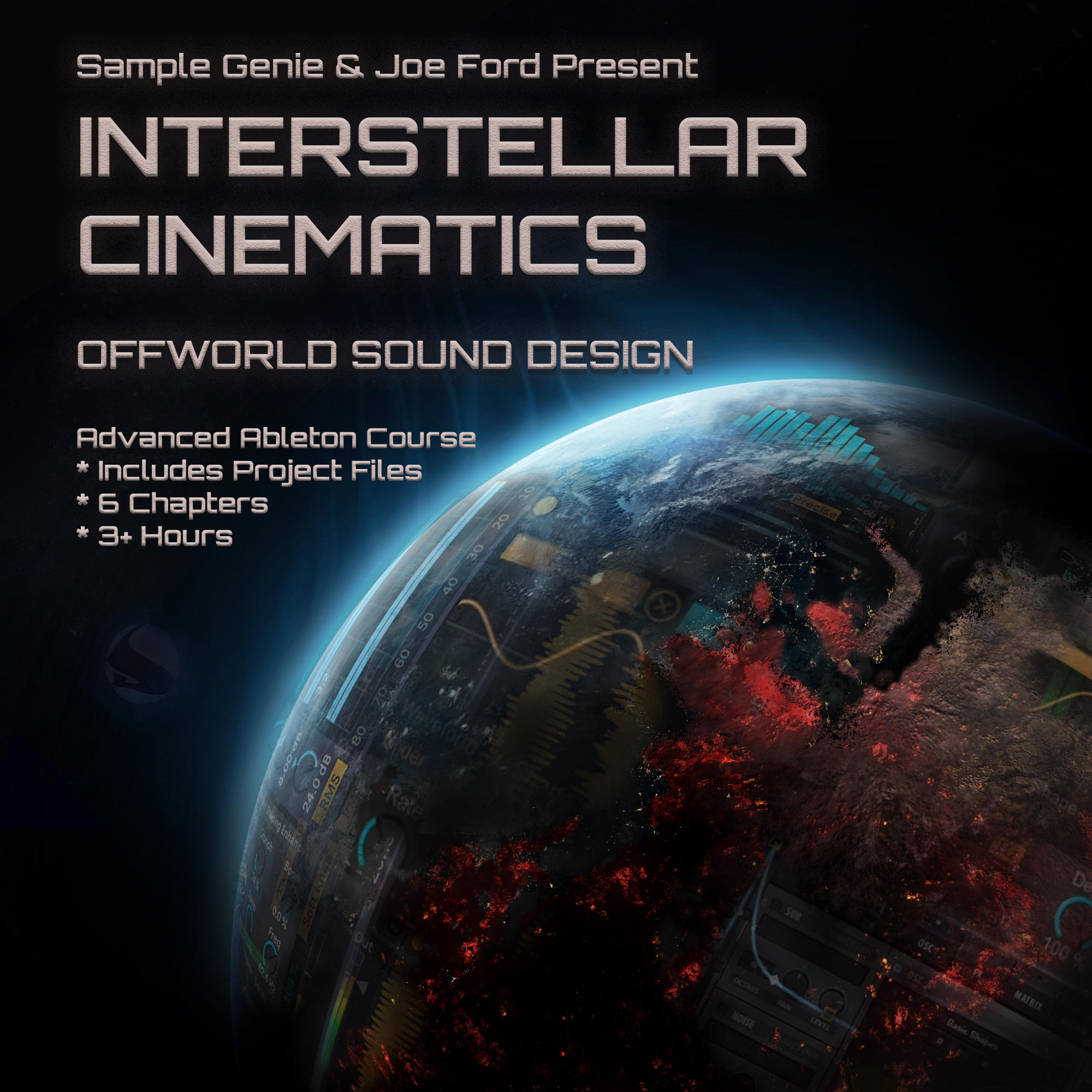Analysis of S5E03: Audeka – Advanced Sound Design
- This topic has 8 replies, 5 voices, and was last updated 6 years, 10 months ago by ,
 atmosfear.
atmosfear.
-
AuthorPosts
-
-
2017-09-12 at 17:47:43 #29568,
 HarryModerator
HarryModeratorDAW used: FL Studio
Topic: sound design, granular synthesis, field recording, workflow, bass design
The video is 45 minutes of Skyler from Audeka experimenting with a field recording, and a few extra elements, including designing a reece bass in FM8. There are stretches in the video where he is just testing out parameters, not much commentary during those portions. The sketch is a 100 BPM piece, and the sound design techniques shown would translate easily to dnb and other genres. His aim is to demonstrate an unorthodox sound, and he references the work of an artist named Murcof (soundcloud.com/murcof-martes/). Skyler wants to evoke cool imagery with his sounds.
—–
WATCH NOTES01:30 – loaded into FL Granulizer the sound of a chair scrapping across the ground, which he first normalized and checked for “cool harmonics”
• Starts with adjusting the grain spacing of the sound.
• Basic info on FL Granulizer: https://www.image-line.com/support/FLHelp/html/plugins/Fruity%20Granulizer.htm
• Basic info on granular synthesis: https://www.soundonsound.com/techniques/granular-synthesis
• Logic X’s Alchemy synth has granular synthesis as one of its available functions
• In Bitwig, there are the Christen Vogel demos that have a few examples of chains built to do granular synthesis using the native sampler plug-in
• There are free and paid plug-in options as well
• Paulstretch could be a good option, although I think I read it’s more of a FFT process than granular synthesis. Somewhere mentioned Audacity can function as a stripped down version of Paulstretch as well02:20 – idea of modulating grain spacing can create other vibrations in the sound, thus creating additional tones or expression of a waveform
03:55 – settles on a sound, moves on to processing, starting with distortion using FabFilter Saturn (a multi-band distortion unit).
• Rest of the chain goes: FL Vocodex -> Fruity EQ 2 -> Fruity Reverb -> a 2nd FF Saturn
06:20 – decides the sound at this point could sound cool if repeated, begins experimenting
08:20 – EQ before distortion looked at
• “The more sound you can pump in to the low end sometimes it makes the way the whole sound behaves interesting.”
09:10 – using FF Saturn to explain multi-band distortion
• Instances of distorting everything versus just a particular frequency band, depends on your goal for the sound
11:00 – added a synth kick to test out an idea
13:00 – getting a sense of a bassline
• Uses a sine bass to test out ideas here
15:45 – testing out “what does it sound like with no low end”
• Does a bounce to get a version that still has the low end
18:20 – more work on the sub, to mimic the pattern of the granulized sound
25:00 – trying out sidechaining on the beat
27:00 – exploring other field recordings
33:00 – trying to add a reece bass using FM8
• Can follow along and try to recreate the patch.
• At 36:00 he puts out a question as to how you can loop the envelope applied to the filter. I guess sort of like a custom drawn LFO?
43:15 – decides the reece did not fit the sketch, but it was an example of designing a bass patch in FM8
—–
THOUGHTS & QUESTIONS
• Seems like a great way to generate a lot of ambient textures, although the idea & practice of creating rhythmic material is probably a key attribute of this tutorial, and something to experiment with. Personally, not sure if this is something big to add to my work, but worth exploring.
• The sounds are interesting at times, I particular like the sweeps created and some of the sound that is like guttural voices chattering. At one point the sketch made me think of Mass Effect 1 and the dance club on the main space station. Disclaimer: I do not play many video games nowadays.—–
Next analysis I’ll be doing will be S1E06: Amoss – Inspired Sound Design, which might compliment this month’s tutorial. Also, S1E03: Hybris – Creative Percussion accompanies this month’s tutorial as well if you are looking for ideas using foley sounds creatively."Knowledge kept is knowledge lost." - Bobbito Garcia
-
2017-09-13 at 10:15:42 #29571,
 dave [rom]Participant
dave [rom]ParticipantThis is really useful info, cheers for the write-up!
-
2017-09-27 at 14:38:03 #29765,
 atmosfearParticipant
atmosfearParticipantI moved this answer as I hit the wrong reply button. there doesn’t seem to be a way to delete it.
-
-
2017-09-13 at 23:51:10 #29584,
Sunken Forest
ParticipantThis was the one I’ve been waiting for after messaging them about their Twitch streams. Super useful content, and while I won’t get the same results with Ableton, it’s incredibly inspiring!
I just wanted to mention, for anyone looking at how to loop the envelopes in FM8; in expert mode, just above the envelope grid, there are two buttons that say ‘sus’ and ‘rel’. ‘sus’ will enable looping between the decay and release markers, ‘rel’ makes the entire envelope act as a one shot.
I hope this helps someone along the way. FM8 is a fantastic synth 🙂
-
2017-09-14 at 16:40:11 #29590,
 GENIE HQKeymaster
GENIE HQKeymasterThanks as always Harry!
And also sunken forest for the FM8 tips..
Can anybody suggest or recommend to the group any good VST granulising tools similar to the one demo’d here in FL? Alchemy is one, but any others people have had experience with?
-
2017-09-14 at 20:36:28 #29597,
 HarryModerator
HarryModeratorThis was the one I’ve been waiting for after messaging them about their Twitch streams. Super useful content, and while I won’t get the same results with Ableton, it’s incredibly inspiring!
I actually was not familiar with their work until checking the video and then listening to stuff. As for not getting the same results, I think that’s actually a good thing in that you get exposed to an idea or a process, try to develop your own take on it, and sometimes you get good results or even different ideas to build off of.
Thanks as always Harry!
And also sunken forest for the FM8 tips..
Can anybody suggest or recommend to the group any good VST granulising tools similar to the one demo’d here in FL? Alchemy is one, but any others people have had experience with?
Sure thing, I’ve found doing these to be fun in some roundabout way.
Here’s a list of granular resynthesis stuff people can try out:
- Granulator: https://www.ableton.com/en/packs/granulator/
Requires Ableton Live and Max For Live - GVST GGrain (free): http://www.gvst.co.uk/ggrain.htm
- Fracture (free): http://glitchmachines.com/downloads/fracture/
Doesn’t expressly say it has granular resynthesis, but the buffer effect might be worth exploring - Hysteresis (free): http://glitchmachines.com/downloads/hysteresis/
Same deal as Fracture although instead of a buffer effect this has a stutter module - The Mangle: http://sound-guru.com/software/mangle/
Saw this mentioned in a few places, just grabbed the demo to try it out
"Knowledge kept is knowledge lost." - Bobbito Garcia
- Granulator: https://www.ableton.com/en/packs/granulator/
-
-
2017-09-17 at 14:40:40 #29622,
 HarryModerator
HarryModeratorThis was just posted on a FB group I’m on; Heavyweight Bass, highly recommended if you like groups. The VST is free, but Windows only.
VST: http://stone-voices.ru/vst/polygas
HWB post:
Gregor Quendel shared a link.
Admin · 6 hrs
#free
‘Stone Voices has released version 2.0 of PolyGAS (Polyphonic Granular Advanced Synthesizer), a free Granular Synth VST instrument plug-in for Windows.
Main features:
32-part polyphony.
Support of files of samples in the WAV and AIFF formats, digit capacity of 8,16,24 and 32-bits / sample, mono / stereo. Files are supported only uncompressed by codecs.
The editor of the bending parameters of granular synthesis. 18 envelopes with the maximum quantity of nodes – 40 (in each envelope). Also there is a tab where it is possible to edit dependence of amplitude of the clicked key bending from a tonality. There is a possibility of synchronization of provisional regulations of nodes of envelopes with rate of composition in DAW.
Controlled randomization of parameters of granular synthesis.
Amplitude non-linear distortions, with a possibility of a type selection (a clipping, bit-crusher, etc.) – only 11 types.
The controlled universal filter allowing as manual installation of frequency of a cutoff (Cutoff) and a resonance (Reson), and by means of envelopes. There is a mode in case of which the frequency of a cutoff depends on a tonality of the clicked key. In the filter different types of filtering (LP, HP, BP, Comb and Allpass), only 11 types are used.
The line of a time delay with modulation realizing effects of Delay and Flanger. There is a possibility of time synchronization of a time delay with rate of composition in DAW, and also the set modes of back coupling (Normal/CrossFeed) and the wave form of a modulating signal LFO (Sine/Triangle).
The reverberator creating high-quality spatial reverberation on Ambient Reverb Stone Voices technology.
The master the section including regulators of low and high frequencies, and also width of a stereobasis and the overall level.
The microtone setup using files of the VAZ/Anamark tuning format format (extension of *.tun and *.scl).
Tools for operation with banks and presets.
Support of MIDI controllers.
Detailed help manual.’"Knowledge kept is knowledge lost." - Bobbito Garcia
-
2017-09-17 at 22:09:10 #29632,
Sunken Forest
ParticipantDang. Windows only, but it sounds awesome!
I use Granulator quite a bit, but really find the lack of legato/portamento a bit of a killer.
-
-
2017-09-27 at 14:40:52 #29766,
 atmosfearParticipant
atmosfearParticipantTop review as usual !
PS: you should play the others Mass Effect, there’s some really cool music in it 😉
-
-
AuthorPosts
- You must be logged in to reply to this topic.


